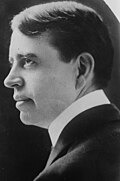| ||||||||||||||||||||||||||||||||||
36 of the 92 seats in the United States Senate 47 seats needed for a majority | ||||||||||||||||||||||||||||||||||
|---|---|---|---|---|---|---|---|---|---|---|---|---|---|---|---|---|---|---|---|---|---|---|---|---|---|---|---|---|---|---|---|---|---|---|
| ||||||||||||||||||||||||||||||||||
 Results of the elections: Democratic gain Democratic hold Republican gain Republican hold | ||||||||||||||||||||||||||||||||||
| ||||||||||||||||||||||||||||||||||
The 1910–11 United States Senate election were held on various dates in various states. As these U.S. Senate elections were prior to the ratification of the Seventeenth Amendment in 1913, senators were primarily chosen by state legislatures. Senators were elected over a wide range of time throughout 1910 and 1911, and a seat may have been filled months late or remained vacant due to legislative deadlock. [1] However, some states had already begun direct elections during this time. Oregon pioneered direct election and experimented with different measures over several years until it succeeded in 1907. Soon after, Nebraska followed suit and laid the foundation for other states to adopt measures reflecting the people's will. By 1912, as many as 29 states elected senators either as nominees of their party's primary or in conjunction with a general election.
Contents
- Result Summary
- Change in composition
- Before the elections
- Elections results
- Beginning of the next Congress
- Race summaries
- Special elections during the 61st Congress
- Races leading to the 62nd Congress
- Elections during the 62nd Congress
- Alabama
- California
- Connecticut
- Delaware
- Florida
- Georgia (special)
- Indiana
- Iowa (special)
- Louisiana (special)
- Maine
- Maryland
- Massachusetts
- Michigan
- Minnesota
- Mississippi
- Mississippi (regular)
- Mississippi (special)
- Missouri
- Montana
- Nebraska
- Nevada
- New Jersey
- New York
- North Dakota
- North Dakota (special)
- North Dakota (regular)
- Ohio
- Pennsylvania
- Rhode Island
- Tennessee
- Texas
- Utah
- Vermont
- Virginia
- Washington
- West Virginia
- West Virginia (regular)
- West Virginia (special)
- Wisconsin
- Wyoming
- See also
- Notes
- References
- Sources
In these elections, terms were up for the senators in Class 1. In conjunction with winning control of the House of Representatives for the first time since the 1892 elections, Democrats flipped 9 Senate seats. This was not enough to flip the Senate, but significantly narrowed the margin of Republican control.
In New York and Florida, the legislature failed to elect until after the beginning of the 62nd Congress on March 4. Special elections were held in six states: Alabama, Georgia, Louisiana, Mississippi, North Dakota, and West Virginia.
















